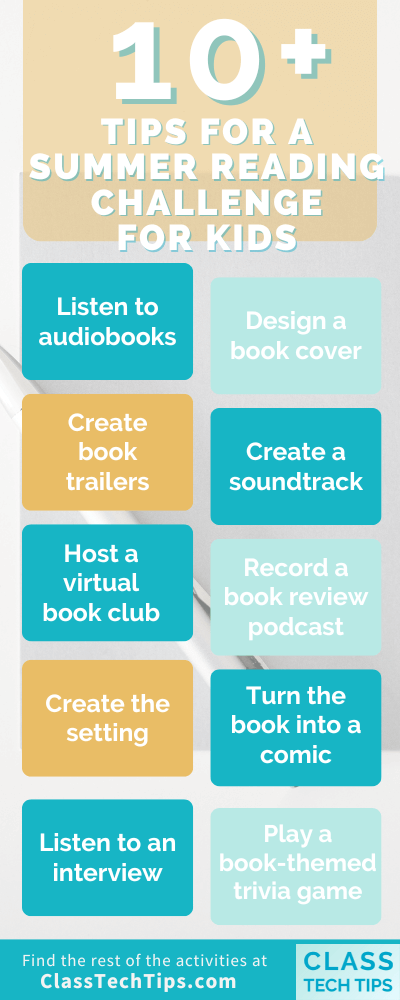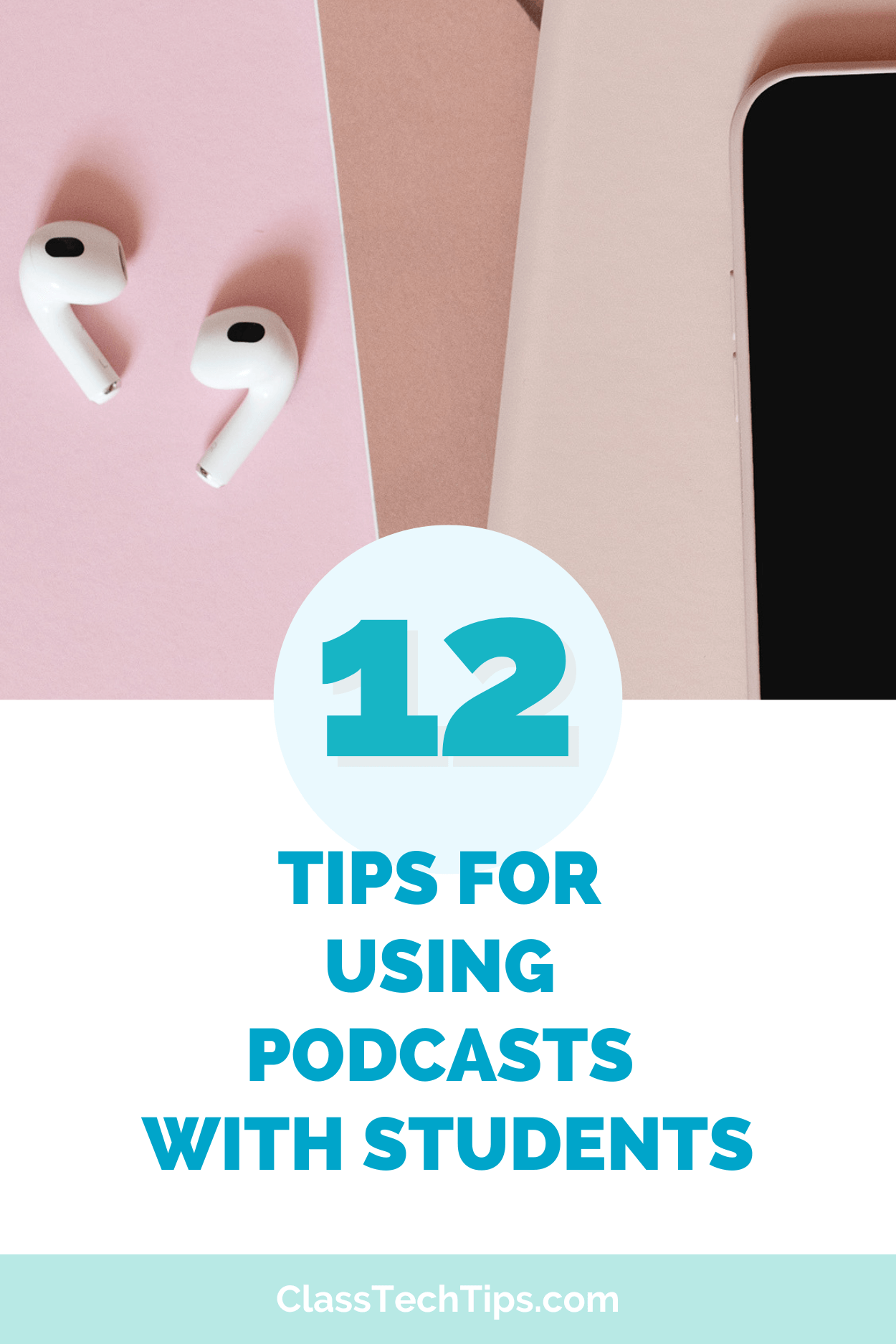Summer is the perfect time to take a spin on traditional classroom reading activities. If you are looking to host a summer reading challenge for kids or simply want to share ideas for families to try out this summer, I have you covered. Today on the blog, we’ll look at over a dozen tips and a handful of favorite EdTech tools.
How can you use this list of tips for summer reading challenges for kids? All the activities below are ready for you to customize for your students. You might tweak a few and then share the complete list with families.
Alternatively, if you send out a weekly newsletter before or during summer break, you might choose to share just one or two of the ideas below each week.
Finding the Perfect Book Match
Before diving into this list of tips for a summer reading challenge for kids, let’s start with the most important part: finding books kids will love!
Here are a few ideas to help them discover new favorites:
- Tap into their interests: Encourage families to ask questions like, “What do you want to learn more about?” This can help narrow down topics, particularly for informational text like dinosaurs or space.
- Consider different genres: If students show an interest in a particular genre, such as mysteries, find books that match those interests and share a list with families before the summer break.
- Encourage a visit to your local library: Librarians are amazing at recommending books and often host summer reading programs. You might send home information to families about a local library so they can decide if they’d like to carve out time to explore a new space.
16 Tech-Infused Summer Reading Challenge Tips
Listen to audiobooks
Check out audiobooks from your library using apps like Libby or Hoopla. These are great for travel or when kids want to read but need a hands-free option. I’ve been a longtime fan of Audible, but this year, I tried out the audiobooks on Spotify. I pay for Spotify premium for music listening, and I was very surprised at just how many titles they offer for free as part of the premium package.

Track books with a digital reading log
Use Google Sheets or a reading log app like Bookly to track book titles, authors, and page counts. Instead of feeling punitive, you might celebrate reading progress at the end of each week or talk about reading goals alongside a log.
Create book trailers
After finishing a book, encourage designing a fun book trailer using apps like iMovie or Adobe Express. I’ve shared a handful of posts on the blog that feature video activities, including this one with tips for using the animated feature in Adobe Express.
Host a virtual book club
Connect with friends via Zoom or Google Meet to discuss favorite books and characters. Even if a group of kids is of different ages or have different interests in reading materials, they can still share favorites and talk about a love of reading.
Write an alternate ending
Spark kids’ creativity by having them write an alternative ending (or even a new chapter!) to a book they loved. If you work at home over the summer, you might recommend digital tools to families that students have already tried out during the school year. For example, if you participated in Be An Author Month this year, you might recommend a familiar tool like Book Creator to families.
Search for the setting
Encourage students to explore the setting of a story through Google Maps or look at a virtual reality-friendly site like Google Arts and Culture. If the setting of the book isn’t very common, you might head to a tool like 360cities.net, which has oodles of content to sort through.
Create the setting
This year on the blog, I’ve shared lots of ideas for using AI, including how to use AI to generate images. You might suggest families explore a tool like Adobe Firefly to generate images together. Then, they can write a prompt together to create an image that represents the setting of their book.
Connect with the author online
Encourage families to check the author’s website or social media. Some authors love interacting with young readers and post content that compliments their most popular books.
Listen to an interview
I’m a big fan of podcasts (here is a blog post with a selection of favorites), and you might find an interview with a favorite kid-friendly author. Authors tend to jump around on different podcasts to promote their books, particularly if they have a new book coming out.
Make a digital character sketch
Ask students to use a drawing app like Sketchbook or Procreate to illustrate their favorite character and include personality traits. They can also use a tool that includes simple drawing tools like Seesaw or Book Creator.
Design a book cover
There are lots of graphic design tools that have templates for students, including templates for book covers. Encourage kids to let their imagination go wild as they create a new cover design for a book they enjoyed. Canva and Adobe Express both have great templates for book covers.
Create a soundtrack
I’ve shared lots of favorite AI tools with educators in my AI in Education Membership, and one favorite is MusicFX. With this Google tool, you can create music based on a text prompt. One part of a summer reading challenge for kids might include having them compose a soundtrack. They can use a generative AI tool and only a text-based prompt.
Record a book review podcast
In addition to having students listen to podcasts about books, as I mentioned earlier, you might ask them to plan and record a short podcast-style book review as part of a summer reading challenge. Plenty of kid-friendly tools are available, including Soundtrap for Education and the iPad app GarageBand. If you’re looking for something even simpler, you might ask them to record audio notes in Book Creator.
Create an “About the Author” presentation
Does your summer reading challenge includes a component where students must read more than one book from the same author? You might encourage them to create an “About the Author” presentation.
Turn the book into a comic
Students can use a comic creation tool like Storyboard That. Or they can use popular tools like Google Slides, which are perfect for this type of activity. If you’d like to try out a few templates for comic books, head to the Free Stuff section of my site, where you’ll find lots of downloads to choose from.
Play a book-themed trivia game
I love a trivia game, and I grew up in a house where we watched Jeopardy every night. For the summertime, you might want to share a few trivia games with kids. A platform like Kahoot! has plenty of ready-to-share trivia games for students.
Reading opens up a world of adventure and exploration for students! For a summer reading challenge for kids, you might focus on giving kids lots of choices. You might encourage families to take a trip to the library and let them roam the shelves. Reading isn’t just about physical books. Explore audiobooks, graphic novels, magazines, and comics this summer!







